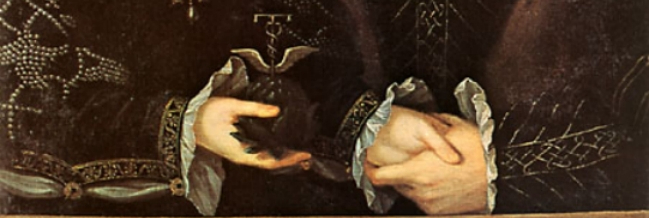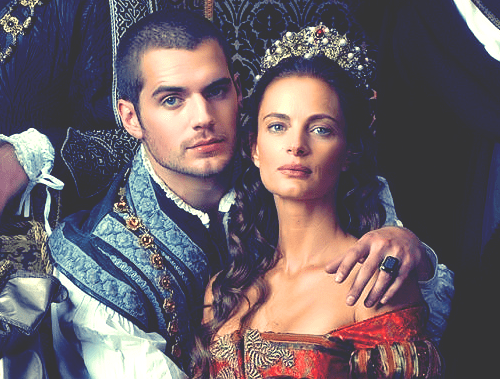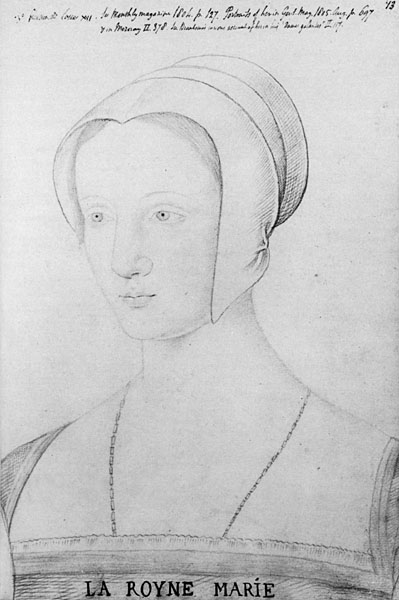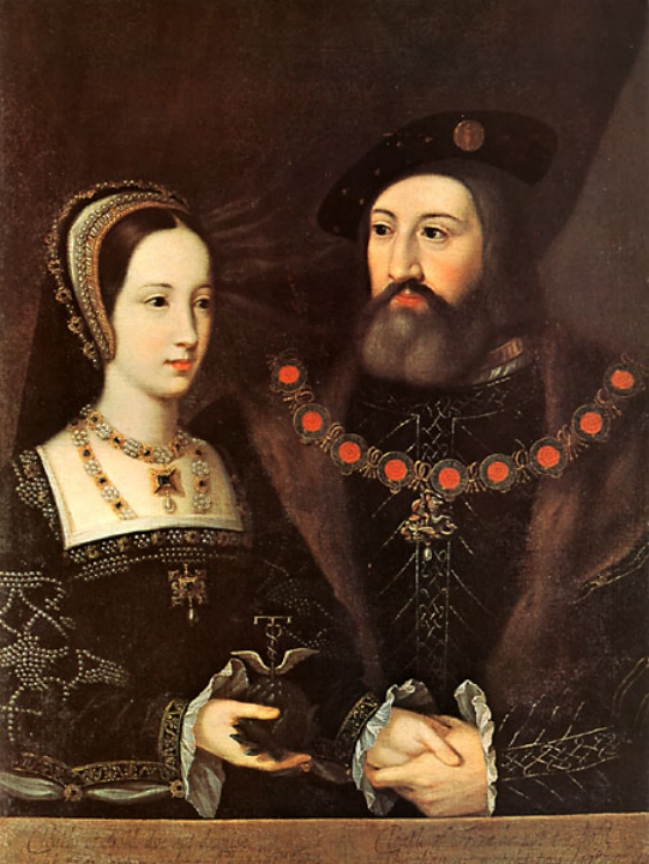Elizabeth of York and Henry VII had the very model of a courtly marriage. Their marriage was not only stable but actually affectionate. I’ve speculated in the past that it was because of their genuine feeling for each other that their own children went on to have such tumultuous experiences with marriage, possibly seeking the stability and feeling demonstrated by their parents. Henry VIII is known more for his six wives (and their fates) than anything else, and I have already written about Margaret Tudor, herself married three times. First, to the King of Scotland who died in battle against England. Then, in secret to a Scottish Lord who she would later divorce in order to marry her lover.
The youngest Tudor, Mary, would also find herself as the subject of a controversial marriage, though arguably she ultimately found the stability and affection denied to her siblings. The character of Margaret Tudor in The Tudors was loosely based on Mary, though named for her sister. In The Tudors, Margaret marries the significantly older King of Portugal only to murder him and secretly marry her lover, Charles Brandon. The only real consistency between the show and history is that Henry’s sister did marry his best friend in secret. She didn’t however kill her husband to do it, and Charles and Mary were very happy together.
Princess of Castile
As the daughter of the King of England, Mary was always going to be a player in the royal marriage market. The first hint of a betrothal came when she was just three years old when the Duke of Milan sought her hand for his son, the Count of Pavia. At five, Mary was promised to Charles of Castile but the arrangement fell through when he was betrothed elsewhere. Aged thirteen, the marriage to Charles of Castile was back on and for six years, Mary would be known as the Princess of Castile.
In 1514, all was set for Mary to marry Charles. Henry VIII had taken especial interest in the marriage of his favourite sister and with her had overseen the directions for an expensive and glamorous new wardrobe to mark the occasion. Her ladies were chosen, the trousseau ready and the bride prepared. The wedding however, was not to be. Charles’ grandfather, Maximilian, the Holy Roman Emperor, delayed the marriage on several occasions and for little real reason. A perceived political betrayal was the final nail in the coffin and humiliated, Henry called the wedding off.
At this point, the eighteen year old Mary Tudor was one of the most eligible women in Europe. On top of this, she was apparently the most beautiful. Certainly, Charles of Castile was less than impressed when their wedding was cancelled. On the 30th June 1514, Mary formally renounced her betrothal to Charles and within a week, she was betrothed to King Louis XII of France as part of a swiftly negotiated peace settlement between the two countries.
Queen of France
On paper, the match was excellent. Mary would become Queen of France, England’s closest Continental neighbour, securing a recently negotiated peace. It might be a step down from being the future Queen of Spain, Germany and Italy, Holy Roman Empress and Lady of the Netherlands but it was an undeniably good match. In practice however, Louis XII was old enough to be Mary’s father and riddled with the infirmity and illness brought by old age. Mary would be his third wife and Louis’ first two marriages hadn’t exactly been simple.
While it might be something of a stereotype in the image of a young and beautiful princess married off to an aged king without her input or consent, most matches of the kind were far more conventional and it raised more than a few eyebrows that such a young woman was marrying such an old man. As the king’s sister, Mary was expected to marry where he told her but whether she used her close relationship with Henry or the unconventional nature of the match, she managed to extract from him a promise that if she married Louis, she could marry where she liked should she survive him. We don’t know for sure if at this point she had someone specific in mind, but we’ll see in coming events that she might well have had an idea.
In October, Mary and her grand retinue set out for France. Before boarding her ship she reminded her brother of his promise. She obviously expected to outlive Louis and given the considerable age gap between them it really wasn’t an unreasonable expectation. Off to France she went. She landed on the 3rd October and met her new husband who she married on the 9th. She was crowned on the 5th November, followed by tournaments in her honour on the 13th. On the 28th December Louis wrote to Henry VIII to tell him how great his wife was before, apparently exhausted from his exertions in the bedchamber, he died on the 1st January less than three months after the wedding.
Mary might have expected a short-lived marriage to Louis but she probably hadn’t considered it would be that short. She had been married for all of eighty-two days and was now the widowed Queen of France, still the most beautiful woman in Europe and, importantly, had her brother’s promise that she could marry whoever she wanted. All in all, she had a good deal for a woman of her station.
There were however, formalities and protocol to observe. She had been married to the king of France and so it needed to be determined that she was not pregnant with a potential heir. She went into seclusion at the Hotel de Cluny to mourn her husband and consider whether she might be carrying the next king of France. It doesn’t seem that anybody took the notion particularly seriously and Louis’ heir, his cousin and son-in-law Francis, was crowned king on the 25th January.
Charles Brandon
At the Hotel de Cluny, etiquette demanded that Mary spend forty days in secluded mourning. In reality, questions were already being raised about who she would marry next. As soon as he heard of Louis’ death, England’s Lord Chancellor, Thomas Wolsey, wrote to Mary telling her not to accept any proposals of marriage and wait to hear from her brother. The new French king offered Mary a husband in a French nobleman, there were rumours that the marriage to Charles of Castile was being reconsidered and two English friars visited Mary, suggesting that her brother almost certainly had a political marriage in mind for her. Mary had already written to her brother, asking that he arrange for her return to England and reminding him not only of his promise but how he had reiterated the promise before she left. She ended the letter by saying if she was not to be married to whom she liked then she would take herself off to a nunnery and marry no one.
Enter: Charles Brandon, Duke of Suffolk.
We don’t know if when Mary and Henry made their agreement she was thinking about marrying Brandon. Her first marriage was expected to be short, but surely nobody expected it to be less than three months short. Brandon was betrothed elsewhere and assuming Mary was free after a few years, he may well have already been married. When Mary received her brother’s promise, she may have only hoped to marry her brother’s young and attractive best friend.
What we do know, or at least, what we can assume with a reasonable amount of certainty, is that when Louis died, Mary had decided Brandon was to be her next husband. In fact, it seemed widely known that the two would soon be married. Brandon, who had competed in the French tournaments held for Mary, was once more dispatched by Henry to retrieve her. Before he left, Henry made Brandon promise not to propose marriage to his sister. Under normal circumstances, this would be a rather odd promise to require before sending an escort, unless of course he expected Brandon to propose on the spot. Brandon duly promised that he would not propose marriage to Mary.
Meanwhile, the two friars who had visited Mary in her seclusion took great pains to stress what a bad match Charles Brandon was. Again, an odd direction for the conversation to turn to unless Brandon was already a contender for her hand. When Francis I, the new King of France, met Brandon and the others in Mary’s escort he did so under the impression that Brandon was there to marry her. It is thought that Mary had already confessed her intent and feelings to Francis and that he had agreed to help her. Francis would later claim that he had assisted because it was all just too darn romantic for him to resist, but in reality it was politically preferable for him that Mary marry an English Duke over a foreign noble.
When Brandon met with Mary in person, he kept his promise to Henry and did not propose to her. He did however, accept when she proposed to him. They were married in secret with ten witnesses present and consummated the union with such haste that within three weeks Brandon was writing to Wolsey that Mary thought she was pregnant. She wasn’t but it was proof enough that the marriage had occurred and couldn’t be annulled for non-consummation.
The story that Brandon put forward was that by the time he reached her, Mary had been quite thoroughly convinced that Henry had no intention of keeping his promise. She believed Brandon there to return her to England where she would be remarried against her will. She had been told by the friars that in England she would never be allowed to marry Brandon and as such, she gave him an ultimatum; either he married her there and then or he would never marry her at all. Committing himself entirely to the king’s leniency Brandon asked, what else could he have done?
Aftermath
Letters now flew between England and France. Mary had triumphed and married the man she so obviously had wanted, but in doing so she had put herself and Brandon in danger. Brandon had many enemies at court, one of whom had probably arranged the visit of the English friars to try and dissuade Mary from wanting to marry him. He was a Duke and had married without his king’s permission when he was already betrothed elsewhere. Far more seriously, he had married a blood relation of the sovereign which was itself punishable by death.
Henry was by all accounts, furious. Mary and Brandon wrote, begging for mercy with Mary accepting full responsibility. The new King of France wrote supporting the match, and even his wife wrote to Henry in support of Mary. Replies came back through Wolsey rather than Henry himself but ultimately, Henry’s apparent rage proved to be more expensive than life threatening. He had apparently been persuaded to accept the marriage but in return, Mary and Brandon were fined an extraordinary sum (which ultimately they did not pay off entirely). Brandon relinquished his lucrative wardship connected to his existing betrothal and they had to to return with Mary’s dowry, her plate, goods and the king’s would have his pick of her jewellery. While still in France, Mary smuggled out a number of jewels that Louis had given her to her brother, including the famous ‘Mirror of Naples’. Described as a large diamond with a hanging pearl ‘the size of a pigeon’s egg’, the Mirror was one of the more impressive pieces in Mary’s possession and she must have known that sending it would go some way to placating her brother. In a move described as ‘plus sale que royale‘ (more dirty than queenly) Mary had it smuggled out with her letters and its theft would prove to be a recurring issue in future negotiations with France.
By the end of March however, Mary at only nineteen years old, had prevailed. She had married the man she loved, her brother accepted it and the couple were married again in a public ceremony in Paris. They were married a third time upon their return to England, given that their second marriage had taken place during Lent which was disallowed under English canon law.
The marriage seems to have been a happy one. The two divided their time between the Duke’s seat at Suffolk and court where they remained popular. They were married for eighteen years, had four children and there are no records or rumours to suggest that Brandon was unfaithful to his wife. The marriage ended with Mary’s death in 1533 at the relatively young age of thirty-seven.
If you’d like to join me for more fun and games in picking apart history, and other behind the scene tangents, you can support me via my Patreon.
















